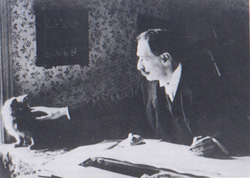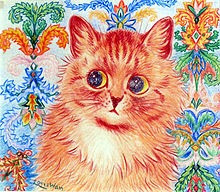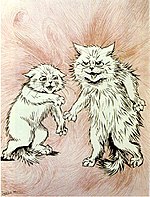Benutzer:Janni93/Louis Wain

Louis William Wain (* 5. August 1860 in London, England; † 4. Juli 1939 in St Albans, Hertfordshire, England) war ein englischer Künstler. Sein Markenzeichen waren anthropomorphe Katzenbilder. Er litt unter Schizophrenie, der Verlauf der Erkrankung läßt sich nach Ansicht mancher Psychologen in Wains Bildern sehen.
Leben und Werk
[Bearbeiten | Quelltext bearbeiten]
Louis Wain war das erste von sechs Kindern und der einzige Sohn seiner Eltern. Seine jüngste Schwester kam im Alter von 30 Jahren in eine Irrenanstalt, nachdem bei ihr eine Geisteskrankheit festgestellt worden war. Seine anderen Schwestern lebten bis zum Tod ihrer Mutter zu Hause.
Wain wurde mit einer Lippen-Kiefer-Gaumenspalte geboren, sein Arzt gab seinen Eltern den Rat, Wain nicht vor dem Alter von zehn Jahren in die Schule gehen zu lassen. Als Heranwachsender schwänzte er häufig die Schule, um in London herumzuwandern.
Nach seinem Schulabschluß studierte Wain an der West London School of Art (heute: Chelsea College of Art and Design), wo er auch für einen kurzen Zeitraum als Dozent tätig war.
Im Alter von 20 mußte Louis Wain nach dem Tod seines Vater seine Mutter und Schwestern unterstützen.
Wain kündigte bald seine Lehrtätigkeit, um als freier Künstler arbeiten zu können.
Er spezialisierte sich in Tier- und Landschaftsbilder und arbeitete für verschiedene Zeitschriften, wie die Illustrated Sporting and Dramatic News und die Illustrated London News.
In den 1880er-Jahren bestand Wains Werk aus detaillierten Illustrationen englischer Landhäuser samt Anwesen und Viehbestand, die er auf Landwitschaftsausstellungen zeichnete. In dieser Zeit zeichnete er eine Vielzahl unterschiedlicher Tiere, eine Begabung, die er sein ganzen Leben beibehielt.
Mit 23 Jahren heiratete Wain die zehn Jahre ältere Gouvernante seiner Schwester, Emily Richardson. Mit ihr zog er nach Hampstead in Nordlondon. Emily erkrankte an Krebs und starb nur drei Jahre nach der Hochzeit.
Die Krankheit seiner Frau beeinflußte Wains Karriere maßgeblich. Emily erfreute sich an ihrem Hauskater Peter, der Louis Wain verschiedene Kunststückchen beigebracht hatte. Louis Wain began ausführliche Zeichnungen der schwarz-weißen Katze anzufertigen. Später schreibt Wain über Peter: „To him properly belongs the foundation of my career, the developments of my initial efforts, and the establishing of my work.“ (deutsch: „Ihm gehört die Grundlage meiner Karriere, die Entwicklung meiner anfänglichen Versuche und die Begründung meines Werks.“).

In 1886, Wain's first drawing of anthropomorphised cats was published in the Christmas issue of the Illustrated London News, titled A Kittens' Christmas Party. The illustration depicted 150 cats, many of which resemble Peter, sending invitations, holding a ball, playing games, and making speeches over eleven panels. Still, the cats remain on all fours, unclothed, and without the variety of human-like expression that would characterize Wain's work. Under the pseudonym George Henri Thompson, he illustrated numerous books for children by Clifton Bingham published by Ernest Nister.
In subsequent years, Wain's cats began to walk upright, smile broadly and use other exaggerated facial expressions, and wear sophisticated contemporary clothing. Wain's illustrations showed cats playing musical instruments, serving tea, playing cards, fishing, smoking, and enjoying a night at the opera. Such anthropomorphic portrayals of animals were very popular in Victorian England, and were often found in prints, on greeting cards and in satirical illustrations such as those of John Tenniel.
Wain was a prolific artist over the next thirty years, sometimes producing as many as several hundred drawings a year. He illustrated about one hundred children's books, and his work appeared in papers, journals, and magazines, including the Louis Wain Annual, which ran from 1901 to 1915. His work was also regularly reproduced on picture postcards, and these are highly sought after by collectors today. In 1898 and 1911 he was chairman of the National Cat Club.
Wain's illustrations often parody human behavior, satirizing fads and fashions of the day. He wrote, "I take a sketch-book to a restaurant, or other public place, and draw the people in their different positions as cats, getting as near to their human characteristics as possible. This gives me doubly nature, and these studies I think [to be] my best humorous work."
Wain was involved with several animal charities, including the Governing Council of Our Dumb Friends League, the Society for the Protection of Cats, and the Anti-Vivisection Society. He was also active in the National Cat Club, acting as President and Chairman of the committee at times. He felt that he helped "to wipe out the contempt in which the cat has been held" in England.
Despite his popularity, Wain suffered financial difficulty throughout his life. He remained responsible for supporting his mother and sisters, and had little business sense. Wain was modest and easily exploited, ill-equipped for bargaining in the world of publishing. He often sold his drawings outright, retaining no rights over their reproduction. He was easily misled, and occasionally found himself duped by the promise of a new invention or other money-making scheme.
He travelled to New York in 1907, where he drew some comic strips, such as Cats About Town and Grimalkin, for Hearst newspapers. His work was widely admired, although his critical attitude toward the city made him the subject of sniping in the press. He returned home with even less money than before due to imprudent investment in a new type of oil lamp.
Mental illness
[Bearbeiten | Quelltext bearbeiten]
From this point, Wain's popularity began to decline. He returned from New York broke, and his mother had died of Spanish influenza while he was abroad. His mental instability also began around this time, and increased gradually over the years. He had always been considered quite charming but odd, and often had difficulty in distinguishing between fact and fantasy. Others frequently found him incomprehensible, and his mode of speaking tangential. His behavior and personality changed, and he began to suffer from delusions, with the onset of schizophrenia. Whereas he had been a mild-mannered and trusting man, he became hostile and suspicious, particularly towards his sisters. He claimed that the flickering of the cinema screen had robbed the electricity from their brains. He began wandering the streets at night, rearranging furniture within the house, and spent long periods locked in his room writing incoherently.
Some speculate that the onset of Wain's schizophrenia was precipitated by toxoplasmosis, a parasitic infection that can be contracted from cats. The theory that toxoplasmosis can trigger schizophrenia is controversial but is the subject of significant research [1].
When his sisters could no longer cope with his erratic and occasionally violent behavior, he was finally committed in 1924 to a pauper ward of Springfield Mental Hospital in Tooting. A year later, he was discovered there and his circumstances were widely publicized, leading to appeals from such figures as H. G. Wells and the personal intervention of the Prime Minister. Wain was transferred to the Bethlem Royal Hospital in Southwark, and again in 1930 to Napsbury Hospital near St Albans in Hertfordshire, north of London. This hospital was relatively pleasant, with a garden and colony of cats, and he spent his final 15 years there in peace. While he became increasingly deluded, his erratic mood swings subsided, and he continued drawing for pleasure. His work from this period is marked by bright colors, flowers, and intricate and abstract patterns, though his primary subject remained the same.

Dr. Michael Fitzgerald disputes the claim of schizophrenia, indicating Wain more than likely suffered from Asperger's syndrome. Of particular note, Fitzgerald indicates that while Wain's art takes on a more abstract nature as he grew older, his technique and skill as a painter did not diminish as one would expect from a schizophrenic.[1] Moreover, elements of visual agnosia are demonstrated in his painting, a key element in cases of Asperger's. If Wain had a visual agnosia, it may have manifested itself merely as an extreme attention to detail.[2]
A series of five of his paintings is commonly used as an example in psychology textbooks to, putatively, show the change in his style as his psychological condition deteriorated with time. However, it is not known if his works of art were actually created in the order they are usually presented, as he did not date them.
H. G. Wells said of him, "He has made the cat his own. He invented a cat style, a cat society, a whole cat world. English cats that do not look and live like Louis Wain cats are ashamed of themselves."
His work is now highly collectable but care is needed as forgeries are common.
Popular culture
[Bearbeiten | Quelltext bearbeiten]The 80s cult new wave band Oingo Boingo (of which popular cinematic composer Danny Elfman was a member) used one of Wain's paintings as an album cover for their 1980 self-titled EP.
Wain's artwork was also featured in British folk/goth group Current 93's album Thunder Perfect Mind
In France, the covers of Lilian Jackson Braun's books from the series of "The Cat Who..." published by 10/18 are illustrated with Louis Wain's cats.
Bibliography
[Bearbeiten | Quelltext bearbeiten]All of Wain's books are in the public domain but none has been reprinted.
- Fun and frolic Verses by Clifton Bingham, Ernest Nister.
- All Sorts of Comical Cats. Verses by Clifton Bingham London: Ernest Nister
- Fun at the Zoo with Verses By Clifton Bingham,
- Funny Favourites. Forty-five Pen-and-Ink Drawings by Louis Wain. London. Ernest Nister.
- Madame Tabby's Establishment (1886)
- Our Farm: The Trouble of Successes Thereof (1888)
- Dreams by French Firesides (1890)
- Peter, A Cat O'One Tail: His Life and Adventures (1892)
- Old Rabbit the Voodoo and Other Sorcerers (1893)
- The Dandy Lion (1900/01)
- Cats (1902)
- Pa Cats, Ma Cats and their kittens (1903)
- Louis Wain's Cat Painting Book (c.1910)
- Louis Wain's Cats and Dogs (c. 1910)
- The Louis Wain Nursery Book (c. 1910)
- Louis Wain's Cat Mascot (postcard coloring book, c.1910)
- Daddy Cat (1915)
- Little Red Riding Hood and Other Tales (1919)
- Somebody's Pussies (1925)
- The Boy who shares my name (1926)
Notes
[Bearbeiten | Quelltext bearbeiten]- ↑ Fitzgerald, Michael. “Louis Wain and Asperger’s Syndrome.” Irish Journal of Psychological Medicine 19/3 (2002): 101
- ↑ McGennis, Aidan. “Louis Wain: his life, his art and his mental illness.” Irish Journal of Psychological Medicine 16/1 (1999): 27
References
[Bearbeiten | Quelltext bearbeiten]- The Cats of Louis Wain, Patricia Allderidge, Bibliotheque de l'Image, 2000, ISBN 2-909808-91-2
- Louis Wain: The Man Who Drew Cats, by Rodney Dale, William Kimber 1968, ISBN 1-85479-098-6
- E. Fuller Torrey and Robert H. Yolken (November 2003). Toxoplasma gondii and Schizophrenia. Emergent Infectious Diseases.
- Louis Wain: A Picture Postcard Checklist by Christine Booth & Brian Lund (Reflections of a Bygone Age, 2003) ISBN 1900138786
- Vincent, Adrian (1989). 100 Years of Traditional British Painting. London: David & Charles. ISBN 0-7153-9446-0